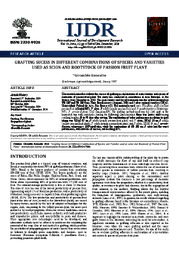Grafting sucess in different combinations of species and varieties used as scion and rootstock of passion fruit plant.
Grafting sucess in different combinations of species and varieties used as scion and rootstock of passion fruit plant.
Author(s): RONCATTO, G.
Summary: Abstract: This research aimed to evaluate the success of grafting in combinations of scion varieties and species of rootstocks of passion fruit plant. The study was conducted in screenhouse at Acre Embrapa, in Rio Branco, from December in 2012. The scion variety used for all treatments was the yellow passion fruit 'FB 100' and 'FB 200' from Flora Brazil nursery (Araguari, MG) and 5 other regional varieties (UFAC, Universidade Federal do Acre, Rio Branco-AC). The rootstocks used were Passiflora edulis (yellow passion fruit) (Cuiabá-MT), P. alata, P. edulis (purple passion fruit) and P. quadrangularis (Guiratinga- MT), P. serrato-digitata (IAC-Campinas/SP). The grafting method used was the cleft graft at the hypocotyl top, with rootstocks having the following characteristics: three true leaves and varying seedling heights, 30 to 90 days after sowing. The combination of better performance in relation to graft taking was UFAC 07 on P. edulis (purple passion fruit plant) and P. alata, UFAC 38 on P. edulis (yellow passion fruit plant), P. edulis (purple passion fruit plant) and P. alata, UFAC 64 on P. serratodigitata, achieving a 100% graft take, while the combination of FB 100 on P. alata had the worst performance, with low rate of success, not reaching 30%.
Publication year: 2024
Types of publication: Journal article
Keywords: Maracujá, Porta Enxerto, Selo ODS, Variedade
Observation
Some of Embrapa's publications are published as ePub files. To read them, use or download one of the following free software options to your computer or mobile device. Android: Google Play Books; IOS: iBooks; Windows and Linux: Calibre.
Access other publications
Access the Agricultural Research Database (BDPA) to consult Embrapa's full library collection and records.
Visit Embrapa Bookstore to purchase books and other publications sold by Embrapa.

